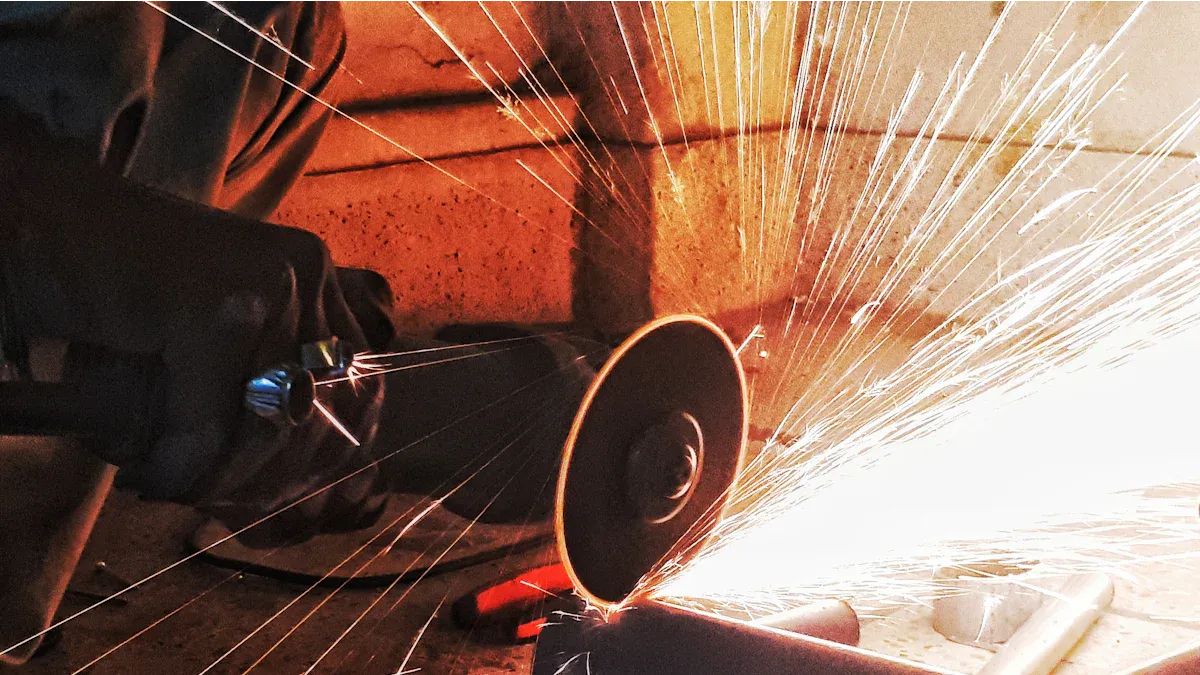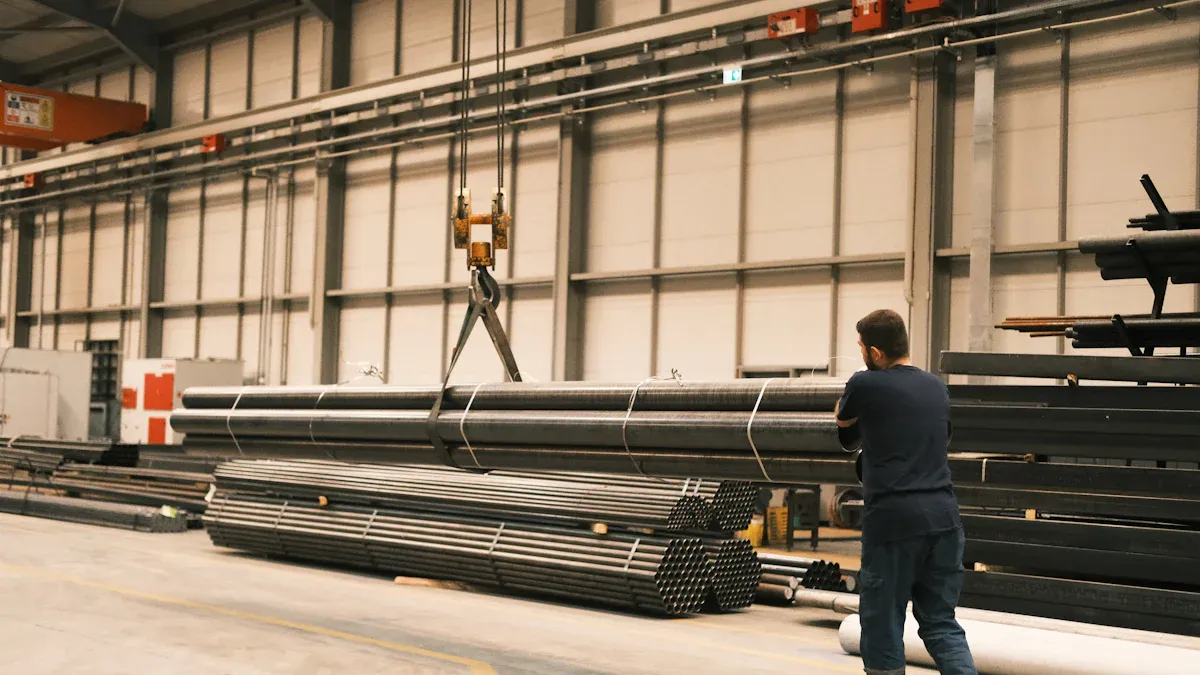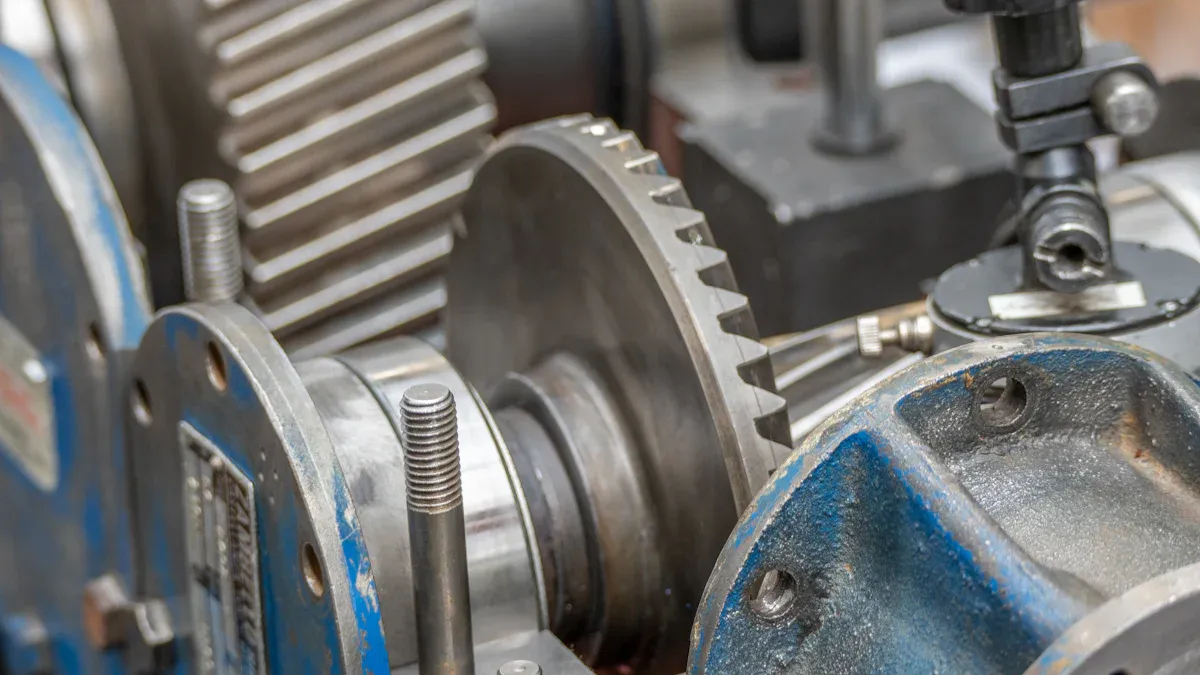Date: 2025.10.13 Click: 16

You use an OCF- CNC Pipe Beveling Machine when you need fast and accurate pipe end beveling.
This machine is new in pipe prefabrication.
It works with a SIEMENS CNC system and uses hydraulic clamping.
You can choose different bevel shapes like U, V, J, Facing, or Counter-boring.
Pipe beveling helps you prepare pipes for welding. CNC technology lets you enter your requirements, then the machine delivers precise results every time.
|
Feature |
CNC Technology |
Manual Methods |
|---|---|---|
|
Precision |
Gives you consistent bevels |
Results can vary |
|
Rework |
Cuts down on mistakes |
More errors likely |
|
Efficiency |
Speeds up your work |
Takes longer |
The OCF- CNC Pipe Beveling Machine provides fast and precise beveling for pipe ends, essential for strong welds.
CNC technology allows for automated, consistent results, reducing human error and increasing efficiency in pipe preparation.
You can choose from various bevel shapes, such as V and J, to meet specific welding needs across different industries.
Safety features, including guards and emergency stops, enhance operator protection and reduce workplace hazards.
Regular maintenance, including cleaning and tool checks, ensures the machine operates effectively and lasts longer.

You use an OCF- CNC Pipe Beveling Machine to prepare pipe ends for welding and joining. This machine helps you get the right bevel shape and angle, which is important for strong welds. You can work with pipes in many industries, such as:
Oil & Gas: You need precise bevels to handle high-pressure pipes and prevent leaks.
Nuclear Industry: You must meet strict safety standards and tight tolerances.
Boilerwork: You want to assemble pipes quickly in tight spaces and reduce downtime.
You can choose from many bevel shapes, including V, J, compound V, compound J, and inside beveling. Each shape fits a different welding need. For example, V-shape bevels work well for standard welding, while J-bevels help you save material during narrow gap welding.
|
Bevel Shape |
Description |
Typical Applications |
|---|---|---|
|
V-shape bevel |
Known as V groove or plain bevel, with angles of 30°, 37.5°, and 45°. |
Used in automated and manual pipe welding. |
|
Compound V-bevel |
Double V groove, similar to V-shape but with a compound angle. |
Used in automated and manual pipe welding. |
|
J-bevel |
Weld end preparation shaped like a J, needs less material for welding. |
Suitable for narrow gap welding processes. |
|
Compound J-prep |
Double J-bevel, for heavy-walled pipes. |
Used in heavy-walled pipe welding. |
|
Inside beveling |
Counterboring, machines the inside of a pipe. |
Ensures uniform land width for welding. |
You can process pipes with unlimited wall thickness. This means you can use the machine for thin pipes or very thick ones without worrying about limits.
You get several important features when you use an OCF- CNC Pipe Beveling Machine. These features make your work easier and more reliable.
|
Feature |
CNC Beveling Machines |
Traditional Beveling Machines |
|---|---|---|
|
Precision |
High precision due to computer control |
Variable precision based on operator |
|
Efficiency |
Enhanced efficiency with reduced manual input |
Lower efficiency, more manual labor |
|
Automation |
Fully automated processes |
Mostly manual operation |
|
Complex Geometry Handling |
Handles complex bevel geometries |
Limited to simpler bevel shapes |
|
Consistency |
Consistent results across operators |
Results vary based on skill |
|
Integration |
Integrates into automated production lines |
Standalone operation |
You can handle large volumes of pipe quickly and accurately. The machine reduces human error and gives you consistent results. You can also add the machine to automated production lines, which helps you speed up your work.
Tip: You get better long-term returns because the machine reduces mistakes and rework.
CNC technology gives you full control over the beveling process. You enter the pipe diameter, wall thickness, and bevel type into the CNC controller. The machine then sets itself up and starts working.
|
Parameter |
Description |
|---|---|
|
Pipe Diameter |
The diameter of the pipe you want to process. |
|
Wall Thickness |
The thickness of the pipe wall. |
|
Bevel Type |
The type of bevel you need (V-type, U-type, compound bevel). |
You get faster beveling speeds and precise bevel angles. The machine keeps your results consistent, even if you process many pipes in a row. Automation also helps you avoid mistakes and reduces the number of rejected pipes.
|
Evidence Type |
Description |
|---|---|
|
Faster Beveling Speeds |
Automated, high-speed plate beveling machines reduce the time you spend beveling pipes. |
|
Precise Bevel Angles |
You get a consistent bevel that meets exact weld specifications. |
|
Reduced Rejects |
Automation minimizes worker fatigue and errors, so you get defect-free products with less rework. |
You can program exact bevel dimensions, angles, and patterns. The machine follows your instructions and delivers the same quality every time. This makes the OCF- CNC Pipe Beveling Machine a smart choice for high-specification projects.
Main Components
You need a strong clamping system to hold each pipe steady during beveling. The clamping system grips the pipe from the inside or outside, depending on the pipe size and shape. This grip keeps the pipe from moving, so you get a smooth and even bevel. You can adjust the clamps for different pipe diameters. Hydraulic clamping systems make this process fast and easy. You save time and reduce the risk of mistakes.
The cutting head shapes the end of your pipe. You can choose different bevel shapes, such as V, J, or compound bevels. The cutting head moves with precision, following the path set by the CNC controller. Manufacturers use strong materials for the cutting head to make sure it lasts a long time and works well. Here is a table showing common materials:
|
Material Type |
Description |
|---|---|
|
Hard-anodized aluminum |
Durable, lightweight construction |
|
Cast aluminum |
Rugged and heavy-duty design |
You get reliable performance and less wear, even when you use the machine for many hours.
The CNC controller acts as the brain of the OCF- CNC Pipe Beveling Machine. You enter the pipe size, wall thickness, and bevel type into the controller. The system then sets the cutting path and speed. You do not need to make manual adjustments. The controller keeps every cut accurate and repeatable. You can store programs for different jobs, which helps you switch between projects quickly.
You stay safe when you use a machine with advanced safety features. The OCF- CNC Pipe Beveling Machine includes many systems to protect you and your team. Here is a table of common safety features:
|
Safety Feature |
Description |
|---|---|
|
Safety Guards |
Prevent accidental contact with moving parts, creating a physical barrier between operator and machine. |
|
Light Towers |
Provide visual indication of the machine's status, helping to quickly assess operational safety. |
|
Safety Mats |
Detect operator presence and stop the machine immediately if someone steps onto the mat. |
|
Enclosed Cutting Area |
Prevent accidental exposure to lasers, enhancing operator safety. |
|
Emergency Stop Buttons |
Allow for immediate shutdown in emergencies, providing reassurance to operators. |
|
Safety Interlocks |
Prevent access to the machine while it operates; if the door opens, the machine stops. |
|
Fume Extraction Systems |
Keep the air clean, protecting operators from harmful fumes during cutting. |
|
Overload and Temperature Sensors |
Monitor machine condition to prevent damage and ensure safe operation. |
|
Collision Detection |
Stops the machine to avoid damage if an obstruction is detected, protecting both equipment and operator. |
|
Software Safety Controls |
Monitor machine status to prevent unsafe operations, enhancing reliability. |
You can work with confidence, knowing the machine will help prevent accidents and keep your workspace safe.
How OCF- CNC Pipe Beveling Machine WorksYou start by preparing your workspace. Make sure the area is clean and free from obstacles. This helps you work safely and keeps your equipment in good condition. Next, you secure the pipe. Use the machine’s clamping system to hold the pipe tightly. This step prevents the pipe from moving during beveling.
After securing the pipe, you assemble the OCF- CNC Pipe Beveling Machine. Attach the cutting tool that matches your desired bevel shape. Check that all parts are in place and properly aligned. You then connect the machine to its power source and turn it on. The setup process ensures you get accurate and safe results every time.
Tip: Always double-check the alignment of the cutting head before you begin. Proper alignment gives you a smooth and even bevel.
You follow a series of steps to operate the machine. Each step helps you achieve a precise bevel on your pipe. Here is a typical sequence:
Prepare the work area.
Secure the pipe.
Assemble the pipe beveling machine.
Install the cutting tool.
Align the machine.
Initiate the beveling process.
Complete the beveling operation.
Inspect the cut.
You begin by making sure your workspace is ready and safe. After you secure the pipe, you assemble the machine and install the correct cutting tool. You align the machine with the pipe to ensure accuracy. When you start the beveling process, the machine shapes the pipe end according to your settings. Once the operation finishes, you inspect the cut to confirm it meets your requirements.
To input parameters, you use the CNC controller. You define the set point position based on pipe thickness and tooling setup. You enter values for the backgauge axes, which control pipe positioning. You set the sheet position parameter and input Y-axis, X-axis, and R-axis values for precise placement. You use G-codes to control movement and M-codes for machine-specific functions. Specialized software can help you enter these parameters more easily.
Note: Accurate parameter input ensures the machine produces the correct bevel every time.
Automation makes your work faster and more reliable. The OCF- CNC Pipe Beveling Machine uses advanced features to adjust settings based on your input. The controller responds quickly to changes in machining parameters. It predicts tool paths and adjusts speeds to match the job. You benefit from high-speed machining, which saves you time.
The machine also supports multi-path control. This feature lets you program and operate multiple tool paths at the same time. You can optimize your workflow and reduce cycle times. Here is a table showing key automation features:
|
Feature |
Description |
|---|---|
|
High-Speed Machining |
The controller responds rapidly to changes in machining parameters, predicting tool paths and adjusting speeds dynamically. |
|
Multi-Path Control |
Allows independent programming and operation of multiple tool paths simultaneously, optimizing workflow and reducing cycle times. |
Automation reduces the chance of mistakes. You get consistent results, even when you process many pipes. The machine adjusts itself based on the parameters you enter, so you do not need to make manual changes for each job. This makes the beveling process efficient and accurate.
BenefitsYou get high precision when you use an OCF- CNC Pipe Beveling Machine. The CNC controller lets you set exact measurements for each pipe. The machine follows your instructions and creates the same bevel every time. You do not have to worry about uneven cuts or mistakes. This level of accuracy helps you meet strict welding standards. You can trust the machine to handle complex bevel shapes with ease. Your finished pipes will fit together perfectly, which makes your welding jobs stronger and more reliable.
You save time and effort with this machine. The OCF- CNC Pipe Beveling Machine works much faster than manual methods. Most pipes take only 5 to 20 seconds to bevel, depending on their size. You can process many pipes in a short time. The machine also reduces waste and rework, which saves you money in the long run. Here is a table that shows how this machine compares to traditional methods:
|
Feature |
OCF-CNC Pipe Beveling Machines |
Traditional Methods |
|---|---|---|
|
Versatility |
High (6-axis movement) |
Limited |
|
Precision and Accuracy |
Very High |
Moderate |
|
Increased Productivity |
Significant |
Low |
|
Complex Geometries |
Capable |
Not capable |
|
Automation |
Integrated |
Manual |
|
Cost Efficiency |
Long-term savings |
Higher waste and rework |
You can see that CNC machines offer better productivity and cost savings. You also get more options for different pipe shapes and sizes.
The average cycle time for beveling pipes using CNC machines is typically between 5 to 20 seconds, depending on the size of the pipe.
You stay safer when you use this machine. The OCF- CNC Pipe Beveling Machine protects you from many hazards found in manual beveling. The machine covers moving parts and keeps your hands away from sharp tools. You face less risk of injury or exposure to dangerous materials. The machine also improves the safety of your workplace.
Enhanced operator protection from potential hazards.
Reduced risk of hand injuries and exposure to hazardous materials.
Overall improvement in workplace safety.
You should always follow safety rules and wear the right gear.
Correct training and compliance with safety guidelines are crucial.
Operators should wear appropriate personal protective equipment (PPE) such as safety goggles, gloves, and hearing protection.
ApplicationsTip: Always check the safety features before you start. Proper use of safety equipment keeps you and your team safe.
You often see pipe beveling machines in the oil and gas industry. Here, you need strong weld joints to handle high pressure and prevent leaks. The beveling process shapes the pipe ends at an angle. This step is crucial for creating welds that last. You use saddle machines and other specialized tools to cut and bevel pipes with high precision. These machines help you achieve the quality needed for safe and reliable pipelines. High-precision pipe preparation ensures that every weld joint meets strict industry standards. When you use a CNC pipe beveling machine, you get consistent results, which is important for safety and efficiency in oil and gas projects.
You rely on pipe beveling machines to keep construction projects on schedule. These machines help you prepare pipes quickly and accurately. Automation increases your productivity and keeps your work consistent. You also lower labor costs because you need less manual work. The table below shows how these machines help you meet project deadlines:
|
Aspect |
Contribution to Timelines |
|---|---|
|
Precision |
Enhances quality of work, reducing rework |
|
Automation |
Increases productivity and consistency |
|
Labor Costs |
Lowers costs through reduced manual labor |
|
Project Deadlines |
Helps meet tight deadlines with efficient processes |
You also benefit from less waste and faster production speeds. Fully automated machines can run continuously, which helps you finish projects on time. When you prepare pipe edges for welding, you ensure strong joints and reduce the need for rework. This process improves safety and saves materials.
You use pipe beveling machines in many shipbuilding tasks. These machines help you prepare pipes for fuel, lubricating oil, cooling water, and compressed air systems. You also use them for engine exhaust pipes and emission pipelines. This work keeps exhaust flow smooth and meets environmental rules. In hydraulic systems, you need precise pipe preparation for good performance. Air conditioning and ventilation systems also require high precision and efficiency. You use these machines to bend pipes for internal supports, railings, and handrails. This work ensures strength and stability throughout the ship. The OCF- CNC Pipe Beveling Machine gives you the accuracy and speed needed for these complex shipbuilding jobs.
You can rely on the OCF- CNC Pipe Beveling Machine to deliver precise and efficient pipe end preparation. This machine handles heavy-duty tasks and supports advanced welding needs.
|
Advantage |
Benefit for You |
|---|---|
|
Precision Cutting |
Achieve accurate bevels easily |
|
Efficiency |
Boost your productivity |
|
Versatility |
Work with many pipe sizes |
|
Safety Features |
Protect your team |
Industry experts see new trends like automation, AI, and portable designs. You will find these machines useful for future projects in oil, gas, and construction.
FAQYou can use this machine with carbon steel, stainless steel, and alloy pipes. It works well with different pipe diameters and wall thicknesses. You can handle both thin and thick pipes for many industries.
You should clean the machine after each use. Check the cutting tools for wear. Lubricate moving parts regularly. Inspect safety features often. Good maintenance helps your machine last longer and work better.
Yes, you can program custom bevel shapes using the CNC controller. You enter the bevel angle, depth, and pattern. The machine follows your instructions and creates the exact shape you need.
Yes, you need proper training before using the machine. Training helps you understand the controls, safety features, and best practices. This keeps you and your team safe during operation.
"4mmx2mm Disc Magnet" from S****** received 4 quotation(s)